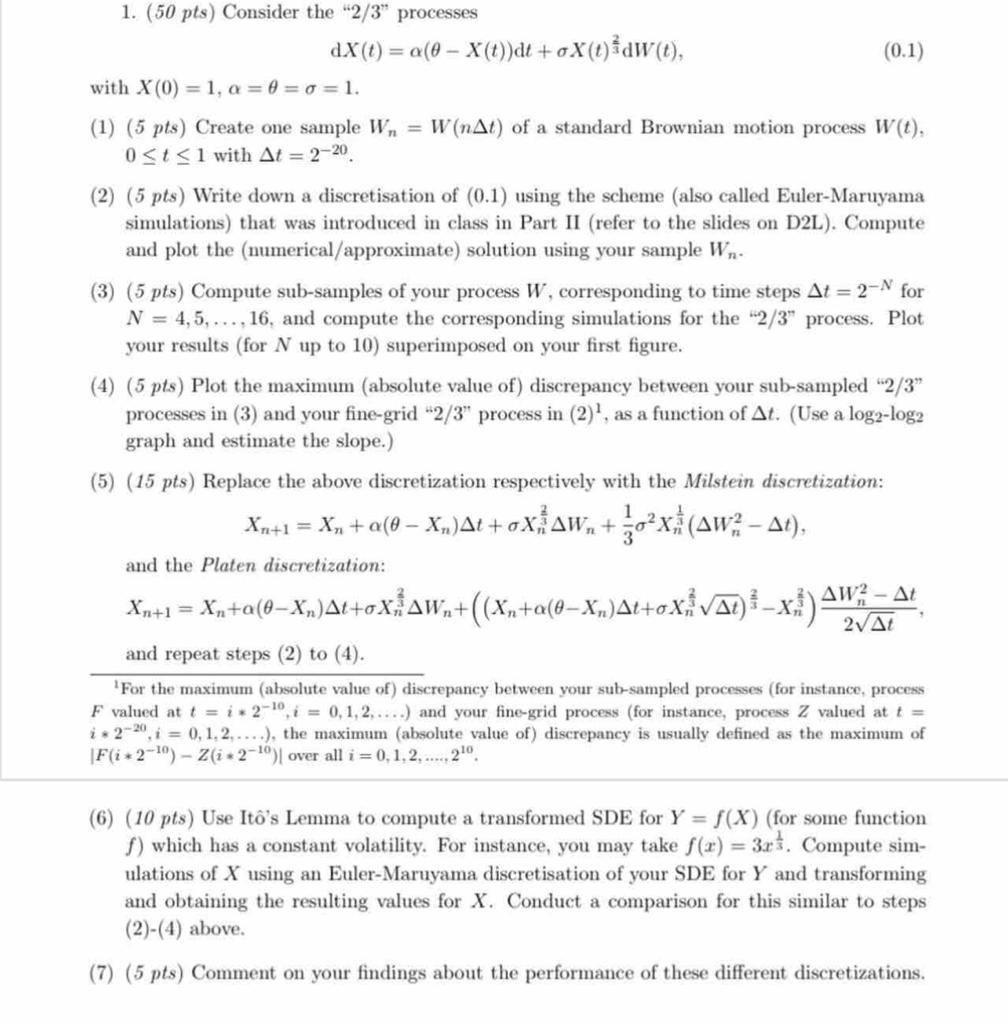 solve using matlab code
solve using matlab code
1. (50 pts) Consider the "2/3" processes dX(t)=(X(t))dt+X(t)32dW(t), with X(0)=1,===1. (1) (5 pts) Create one sample Wn=W(nt) of a standard Brownian motion process W(t), 0t1 with t=220. (2) ( 5 pts) Write down a discretisation of (0.1) using the scheme (also called Euler-Maruyama simulations) that was introduced in class in Part II (refer to the slides on D2L). Compute and plot the (numerical/approximate) solution using your sample Wn. (3) ( 5 pts) Compute sub-samples of your process W, corresponding to time steps t=2N for N=4,5,,16, and compute the corresponding simulations for the 2/3 process. Plot your results (for N up to 10 ) superimposed on your first figure. (4) (5 pts) Plot the maximum (absolute value of) discrepancy between your sub-sampled "2/3" processes in (3) and your fine-grid " 2/3 " process in (2)1, as a function of t. (Use a log2 - log2 graph and estimate the slope.) (5) (15 pts) Replace the above discretization respectively with the Milstein discretization: Xn+1=Xn+(Xn)t+Xn32Wn+312Xn31(Wn2t), and the Platen discretization: Xn+1=Xn+(Xn)t+Xn32Wn+((Xn+(Xn)t+Xn32t)32Xn32)2tWn2t, and repeat steps (2) to (4). 1 For the maximum (absolute value of) discrepancy between your sub-sampled processes (for instance, process F valued at t=i210,i=0,1,2,. ) and your fine-grid process (for instance, process Z valued at t= i220,i=0,1,2,.), the maximum (absolute value of) discrepancy is usually defined as the maximum of F(i210)Z(i210) over all i=0,1,2,.210. (6) (10 pts) Use It's Lemma to compute a transformed SDE for Y=f(X) (for some function f) which has a constant volatility. For instance, you may take f(x)=3x31. Compute simulations of X using an Euler-Maruyama discretisation of your SDE for Y and transforming and obtaining the resulting values for X. Conduct a comparison for this similar to steps (2)-(4) above. (7) ( 5 pts) Comment on your findings about the performance of these different discretizations. 1. (50 pts) Consider the "2/3" processes dX(t)=(X(t))dt+X(t)32dW(t), with X(0)=1,===1. (1) (5 pts) Create one sample Wn=W(nt) of a standard Brownian motion process W(t), 0t1 with t=220. (2) ( 5 pts) Write down a discretisation of (0.1) using the scheme (also called Euler-Maruyama simulations) that was introduced in class in Part II (refer to the slides on D2L). Compute and plot the (numerical/approximate) solution using your sample Wn. (3) ( 5 pts) Compute sub-samples of your process W, corresponding to time steps t=2N for N=4,5,,16, and compute the corresponding simulations for the 2/3 process. Plot your results (for N up to 10 ) superimposed on your first figure. (4) (5 pts) Plot the maximum (absolute value of) discrepancy between your sub-sampled "2/3" processes in (3) and your fine-grid " 2/3 " process in (2)1, as a function of t. (Use a log2 - log2 graph and estimate the slope.) (5) (15 pts) Replace the above discretization respectively with the Milstein discretization: Xn+1=Xn+(Xn)t+Xn32Wn+312Xn31(Wn2t), and the Platen discretization: Xn+1=Xn+(Xn)t+Xn32Wn+((Xn+(Xn)t+Xn32t)32Xn32)2tWn2t, and repeat steps (2) to (4). 1 For the maximum (absolute value of) discrepancy between your sub-sampled processes (for instance, process F valued at t=i210,i=0,1,2,. ) and your fine-grid process (for instance, process Z valued at t= i220,i=0,1,2,.), the maximum (absolute value of) discrepancy is usually defined as the maximum of F(i210)Z(i210) over all i=0,1,2,.210. (6) (10 pts) Use It's Lemma to compute a transformed SDE for Y=f(X) (for some function f) which has a constant volatility. For instance, you may take f(x)=3x31. Compute simulations of X using an Euler-Maruyama discretisation of your SDE for Y and transforming and obtaining the resulting values for X. Conduct a comparison for this similar to steps (2)-(4) above. (7) ( 5 pts) Comment on your findings about the performance of these different discretizations
 solve using matlab code
solve using matlab code





